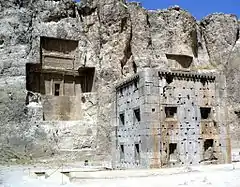Adur-Anahid
Adur-Anahid (Middle Persian: 𐭠𐭲𐭲𐭲𐭲 𐭦𐭩 𐭲𐭲𐭲𐭲𐭩𐭲) was a high-ranking 3rd-century Iranian noblewoman from the royal Sasanian family, who wielded the title of Queen of Queens (banbishnan banbishn). She was a daughter of the second Sasanian King of Kings of Iran, Shapur I (r. 240–270).
Name
Her name is most likely a combination of adur ("fire") and the name of the Iranian goddess, Anahita.[1] Originally thought to mean "Fire of Anahita", her name is now agreed to mean "Fire and Anahita".[1]
Biography

Adur-Anahid was a daughter of the second Sasanian King of Kings of Iran, Shapur I (r. 240–270).[1] She is mentioned twice in an inscription on the wall of the Ka'ba-ye Zartosht at Naqsh-e Rostam near Persepolis in southern Iran, which Shapur I had created in c. 262.[2][1] In the first paragraph, Shapur I claims to have ordered the establishment of fires for his daughter Adur-Anahid and three of his sons, Hormizd, Shapur, and Narseh.[1][3][lower-alpha 1] The fire established for Adur-Anahid was named Husraw-Adur-Anahid.[5] In the second paragraph, Shapur I claims to have rewarded Adur-Anahid, along with princes and other high-ranking members of the court by ordering sacrifices in their names.[1][3] Adur-Anahid is mentioned with the title of Queen of Queens (banbishnan banbishn) in the inscription.[6][1]
The German Iranologist Walther Hinz has suggested that Adur-Anahid was the spouse of her father Shapur I, demonstrating the practice in Zoroastrianism of khwedodah, or close-kin marriage.[1] However, this is opposed by other scholars, who have deduced that the title of members of the royal family illustrated their social status rather than family status.[1][3] The title of "Queen" was wielded by all women of the royal Sasanian family, including the king's daughters and sisters, and the spouses of Sasanian princes.[3] The title of Adur-Anahid thus demonstrated her status as the highest ranking woman in the court.[3][1] There is no suggestion that she practiced kwedodah with her father.[1] According to the modern historian Maria Brosius, "Analysis of the written evidence for the Sasanian period does not permit the conclusion that the Sasanian kings favored incestuous marriages."[3]
Notes
- Adur-Anahid also had two other siblings named Shapurdukhtak and Bahram.[3][4]
References
- Gignoux 1983, p. 472.
- Rapp 2014, p. 28.
- Brosius 2000.
- Shahbazi 1988, pp. 514–522.
- Spawforth 2007, p. 63.
- Sundermann 1988, pp. 678–679.
Sources
- Brosius, Maria (2000). "Women i. In Pre-Islamic Persia". Encyclopaedia Iranica. London et al.
- Gignoux, Ph. (1983). "Ādur-Anāhīd". Encyclopaedia Iranica, Vol. I, Fasc. 5. London et al. p. 472.
- Rapp, Stephen H. (2014). The Sasanian World through Georgian Eyes: Caucasia and the Iranian Commonwealth in Late Antique Georgian Literature. Ashgate Publishing, Ltd. ISBN 978-1472425522.
- Shahbazi, A. Shapur (1988). "Bahrām I". Encyclopaedia Iranica, Vol. III, Fasc. 5. pp. 514–522.
- Spawforth, A. J. S. (2007). The Court and Court Society in Ancient Monarchies. Cambridge University Press. ISBN 9781139466639.
- Sundermann, W. (1988). "Bānbišn". Encyclopaedia Iranica, Vol. III, Fasc. 7. London et al. pp. 678–679.